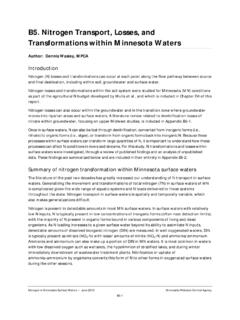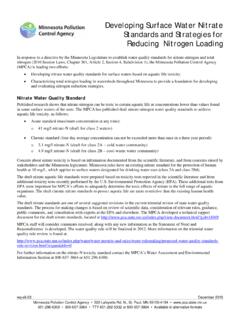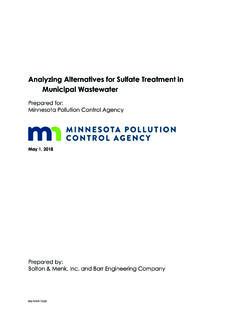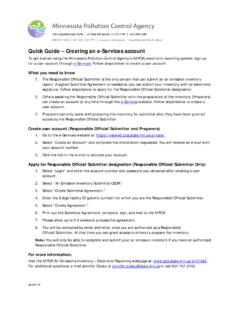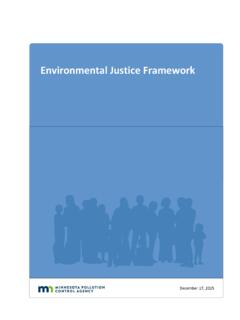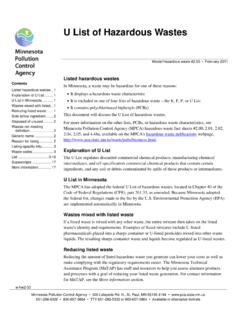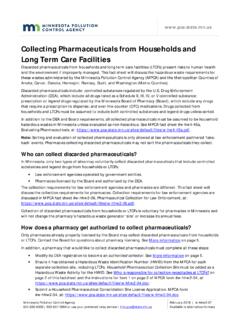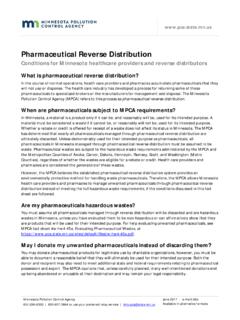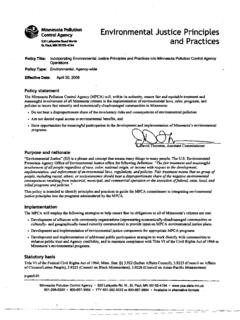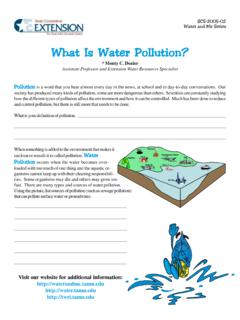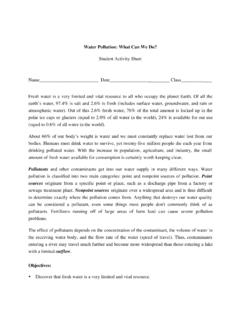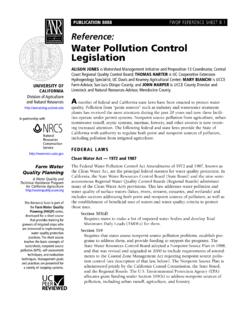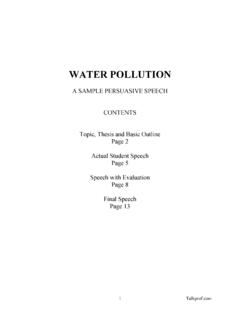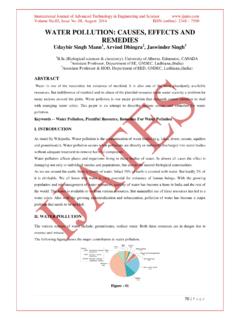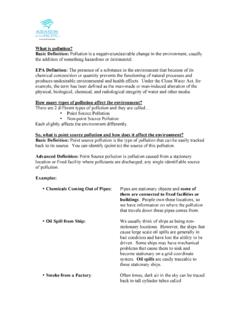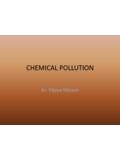Transcription of Bacteria: Sources, Types, Impact on Water Quality
1 bacteria : Sources, types , Impact on Water Quality - A General Overview Water Quality /Impaired Waters # February 2008 Minnesota Pollution Control Agency 520 Lafayette Rd. N., St. Paul, MN 55155-4194 651-296-6300 800-657-3864 TTY 651-282-5332 or 800-657-3864 Available in alternative formats Fecal coliform and E. coli bacteria found in rivers and steams throughout the state originate in human, pet, livestock, and wildlife waste. wq-iw3-20 The actual numbers of people made ill in Minnesota from pathogens in surface Water is not clearly understood. Most gastrointestinal illness, the most likely to be associated with surface Water pathogens, goes unreported.
2 MPCA Offices: Rochester: 507/285-7343 Mankato: 507/389-5977 Marshall: 507/537-7146 Willmar: 320/214-3786 Detroit Lakes: 218/847-1519 Brainerd: 218/828-2492 Duluth: 218/723-4660 Metro: 651/296-6300 Toll-Free Number: 800/657-3864 ountless numbers of bacteria , viruses, and other microorganisms exist in the environment land and Water and also in the bodies of humans and animals. Most are beneficial, serving as food for larger organisms, and playing critical roles in biogeochemical cycles such as organic matter decomposition, fixation of nitrogen, and digestion of food. However, about 10 percent are harmful. Known as pathogens, if ingested by humans, they can release toxins causing sickness or even death.
3 Symptoms of waterborne diseases may include gastrointestinal illnesses such as severe diarrhea, nausea, and possibly jaundice as well as headaches and fatigue. It is important to note, however, that these symptoms are not associated only with disease-causing organisms in drinking Water . They may also be caused by a number of other factors. In addition, not all people will be affected to the same degree; young children and the elderly are usually more susceptible. Fecal Coliform and E. coli In Water pollution control and Water Quality monitoring, specific disease-producing (pathogenic) organisms are not easily identified. Testing for them is difficult, expensive, and time-consuming.
4 Two closely related bacteria groups have been used for decades as indicator organisms. Fecal coliform and E. coli bacteria provide an indication of the possible presence of pathogens. E. coli is a sub-group of fecal coliform, and is virtually always present in Water along with fecal coliform. Protozoa, microorganisms such as Giardia and Cryptosporidia, may also be present in animal waste and can be disease-causing in humans. Campers using lake or stream Water for drinking or cooking must filter it to remove protozoa beforehand. Factors Affecting bacteria As with many Water pollutants, the behavior of fecal coliform and E. coli in the environment is complex. Factors affecting bacteria levels include seasonal weather, stream flow, Water temperature, distance from pollution sources, livestock management practices, wildlife activity, age of fecal material, sewage overflows, and rainfall.
5 In addition, bacteria in stream sediments can survive for extended periods and even grow. Despite the potential for growth of bacteria in stream sediments, die-off is still the dominant process. Sources and Pathways to Water Fecal coliform and E. coli bacteria found in rivers and steams throughout the state originate in human, pet, livestock, andC bacteria : Sources, types , Impact on Water Quality wq-iw3-20 February 2008 page 2 Focus on Streams, Rivers Although bacteria Water Quality standards apply to all waters in Minnesota, the MPCA generally focuses its assessment work on rivers and streams rather than lakes for two reasons: 1) bacteria levels in lakes generally tend to be lower than those seen in streams and rivers.
6 2) The types of bacteria sources over which the MPCA has the clearest authority are more likely to discharge directly to a stream or river than a lake. If the stream or river feeds a lake, bacteria levels are often much reduced before reaching the lake. Bacterial contamination in lakes is often associated with designated swimming beaches affected by users ( children in diapers), which typically is dealt with by local health officials. wildlife waste. Amounts tend to be lower in the forested and wetland-rich areas of northern Minnesota, and higher in agricultural and more heavily populated areas. Pathways include direct routes to surface waters (illicit septic systems connections, wastewater treatment facility discharge points, and urban stormwater systems), spills or runoff from livestock housing or manure storage facilities, runoff or movement through soil from agricultural lands that receive manure applications, runoff of wildlife dropping, and direct deposition into waterways by wildlife or grazing animals.
7 Manure management practices including manure storage and pretreatment ( composting), timing and rate of application, and application method, all have the potential to reduce bacteria contamination of surface and groundwater. The actual numbers of people made ill from pathogens in surface Water is not clearly understood. Most gastrointestinal illness, the most likely to be associated with surface Water pathogens, goes unreported. Outbreaks that are documented typically are associated with designated swimming beach areas where a number of bathers become ill. According to one study, 35 percent of all gastrointestinal illness is caused by pathogen-contaminated drinking Water .
8 Information Sources Minnesota Department of Health: Water Quality Standards Pathogen Basics , National Livestock and Poultry Environmental Learning Center: (Scroll to Jeanette Thurston-Enriquez, Pathogens in Animal Manure-Should We Be Concerned?-Part 1). For most Water bodies in the state, standards for bacteria are designated by law to support full or partial body-contact recreational uses such as swimming, wading, boating, and fishing. Recently, Minnesota proposed changing the criteria for detecting pathogen levels from the fecal coliform to the E. coli standard. The Environmental Protection Agency has been encouraging states to adopt the new standard for reasons of better Quality , lower cost and greater efficiency.
9 A Farmer's Guide to Agriculture and Water Quality Issues North Carolina State University College of Agriculture and Life Sciences: The current standard is for fecal coliform: A monthly average of 200 colony-forming units per 100 milliliters of Water (cfu/mL), and a maximum of 2,000 cfu/100 mL not to exceed 10 percent of samples collected in a month. The proposed rule revision will replace fecal coliform with an E. coli standard of 126 cfu/100 mL monthly average, and 1,260 cfu/100 mL maximum. The standards apply April through October (for most waters). When they are exceeded, the Water is considered impaired and not fully supporting the designated use. People using impaired waters for recreation are at risk for exposure to pathogens.
10 Lower Mississippi River Basin Fecal Coliform bacteria Total Maximum Daily Load Report: Proposed Water Quality Standards Rule Revisions: Assessing Quality of Minnesota Surface Waters.
